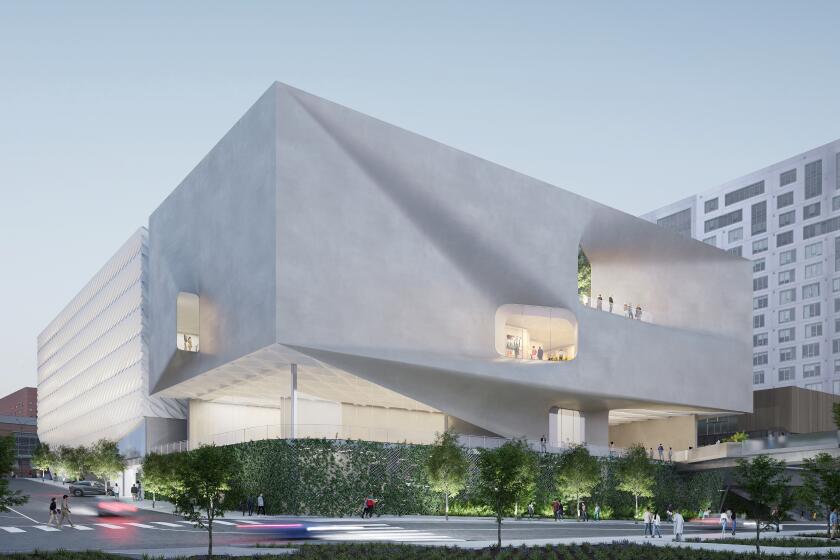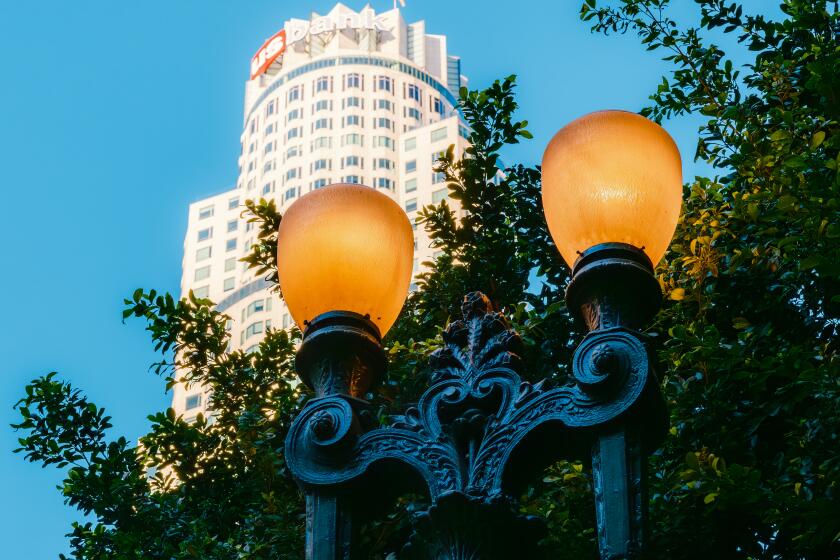Courts with a new spark
ANYBODY who has moved from city to city over the years -- and that describes a significant portion of America’s urban population these days -- knows there are two kinds of apartments you tend to remember: the ones you couldn’t wait to get out of, and the ones whose charms stick with you, as a kind of regret, years after you’ve left.
Before I moved from Northern to Southern California last year, my wife, baby daughter and I lived in a place that belongs to the second category: a one-bedroom apartment with a fireplace, a window seat and a secluded patio in a garden court complex in Piedmont, in the hills just south of Berkeley. The single-story complex, which includes nine rental apartments arranged, in a pair of U-shaped arms, around a shared garden, was probably designed by the architect Irving Gill.
“Probably” because the origins of the complex, finished in 1914 and known as Ronada Court, aren’t entirely clear. Gill’s archive is scattered; many of Piedmont’s records from the period are lost. The units certainly include several of Gill’s trademarks, such as arched doors and windows and a crisply economical, superbly proportioned flat-roofed style, which is largely Modernist with some nods to Mission and Craftsman styles.
Still, it was less the connection to a famous name that impressed me than the thoughtful and unusually livable quality of its design, and the way quick access to the garden always made it feel bigger and more luxurious than it actually was. The largest closet in each unit was placed back-to-back to its counterpart next door, which meant that almost no noise leaked into our place from the neighboring one. The architect (who, if it wasn’t Gill, certainly knew his work) placed bathrooms and kitchens on the street side, with bedrooms and living rooms away from the noise.
Indeed, our apartment, despite some leaks and an unreliable, undersized dishwasher, was so agreeable that we stayed after our daughter arrived and it became clear that we needed more space. The apartment included a long, narrow extra room that originally may have been an open-air loggia and that we were using as a dining room; we moved our bed to the far end of that space and turned the lone bedroom into a nursery.
The courtyard apartment, of course, is an architectural type perfected in, and intimately associated with, Southern California. (Even the idea of naming an apartment building seems out of place in Northern California; nobody except architectural historians refers to ours as Ronada Court.) Nearly all of the best examples of the style are found here: Gill’s own Horatio West Court in Santa Monica; Neutra’s Strathmore Apartments in Westwood; the row of unabashedly romantic Mediterranean-style buildings along and near Fountain Street in West Hollywood; bungalow courts in Pasadena; and countless others.
Built mostly in the 1920s and ‘30s, the Los Angeles courts, whose most direct historical precedents are the California Missions and the courtyard apartments of Seville, Cordoba and other Spanish cities, come in a remarkable variety of architectural styles. What they have in common is a remarkable combination of symbolizing Southern California living while at the same time suggesting a remove from its urban bustle. To wander through Robert Stacy-Judd’s neo-adobe Atwater Bungalows near Elysian Park, for instance, is to be convinced that you are, first, completely isolated from city life and, second, that you are in a place that could only be Los Angeles. The courtyard type also strikes an unusually effective balance between privacy and sense of community.
In their 1982 book “Courtyard Housing in Los Angeles,” Stefanos Polyzoides, Roger Sherwood and James Tice note a quirk of history that helped inspire at least a handful of California architects in their adaptation of European courtyard buildings: World War I kept young architects from taking the traditional Grand Tour through Frances, Italy and other countries. Many wound up in southern Spain, where safe travel was still possible, admiring the richly detailed courts in the Andalusian region, where the climate and quality of light reminded some of Southern California.
For a while, the garden and bungalow courts seemed poised to help bring about a denser, more urban and more connected Los Angeles. But as the 20th century wore on, developers, public officials and other L.A. boosters began marketing Southern California, with increasing fervor and effectiveness, as a place where even a middle-class family could afford its own private house on a detached lot. And as the market for single-family housing boomed, apartment living began to be seen as more down-market and less urbane than it had before.
On top of that, major architects grew less interested in building middle-class housing than their predecessors. Gill, for example, was among many American architects of his generation who were deeply influenced by Modernism’s commitment to bringing good design to the masses. His garden court in Sierra Madre, finished in 1910 and the closest model for Ronada Court, was designed specifically for working-class residents. But a generation later that influence had faded noticeably.
As a result of those trends, few courtyard complexes of note were built in the decades between World War II and the end of the century. There were, of course, some new “Melrose Place”-style buildings ringing a shared swimming pool. But those designs owed as much to motel architecture as to courtyard designs, and as a result they are charged with a certain transitory quality that undercuts any sense of community.
The way Southern California has grown since the first generation of courtyard apartments appeared has brought both their desirability and vulnerability into sharper focus. The region’s rising density -- this is now the densest metropolitan region in the country, according to the 2000 census -- has been keenly tracked by developers, who are now preparing to build high-rise apartment and condominium towers at a remarkable rate over the next decade. Many of the city’s most talented architects, including Frank Gehry, have been enlisted to design them. Meanwhile, vintage courtyard complexes continue to come under pressure from developers intent on knocking them down to build something more lucrative in their place.
If you are not a developer, the appeal of these new condo towers, especially in a place like Los Angeles, can be difficult to understand. In Chicago or Boston or even Phoenix, where extreme weather makes indoor living attractive, such apartments might make sense. But in this city, where so much of the appeal has to do with the ability to spend time outdoors year-round, anybody who makes his or her primary residence in an upper-floor condo with sealed windows and without even a terrace seems to be missing something basic about Southern California living.
Indeed, in our haste to move from the single-family paradigm that has always defined Los Angeles in the eyes of the world to hyper-dense, high-rise residential development we seem to be jumping right over a highly attractive compromise option: affordable, mid-density, low-rise housing that is best exemplified by courtyard complexes and bungalow courts.
There are economic pressures keeping this sort of development off the market, of course. Developers in Los Angeles, as everywhere, are more concerned with maximizing profit than maximizing architectural charm or livability. Another problem, frankly, is that architects here have struggled to come up with a contemporary twist on the courtyard type that would be attractive to developers, planners and potential residents alike. Because the courtyard apartment is seen as a historical rather than a vital style by developers and design-review boards, the architecture of new garden court complexes tends to be deeply nostalgic. This is in contrast to the first generation of courtyard projects -- including Gill’s work -- that may have looked to European or Mission designs but also helped break new ground architecturally and in terms of American urbanism.
The Pasadena firm Moule & Polyzoides, for example, has been working hard to bring back the courtyard apartment as a viable architectural type, and has produced impeccably designed examples in West Hollywood, where the 7 Fountains building opened in 2002, and in South Pasadena, where a new bungalow court project by the firm has just opened.
Although those efforts may advance the courtyard revival from a development and zoning point of view -- the husband-and-wife team of Elizabeth Moule and Stefanos Polyzoides are also founders of the Congress for the New Urbanism, and have a highly informed and comprehensive approach to residential development -- they have done little to move it forward architecturally. And they suffer from a problem common to well-designed urban architecture these days: They are so appealing that they are unaffordable to all but the wealthy. The 20 apartments in 7 Fountains, for example, rented for $3,500 to $7,000 per month when the complex opened, and have become more expensive since then.
But it seems to me that there is a market -- made of people who are sophisticated about design but priced out of the current housing market -- not just waiting for a more contemporary spin on the garden apartment but practically desperate for it. It will take creativity on the part of architects, developers and planners to make such projects viable, but nothing in real estate is impossible when you have ready buyers.
And policymakers and planners could help. Cities could require that for every new high-rise tower that is approved another project with lower density and outdoor access is mandated in another location. They could insist that a certain percentage of new housing developments match the size and shape of the low-rise apartments they replace. Moule and Polyzoides, for their part, suggest a shift from use-based to form-based zoning as a way to break the grip of unimaginative developers on the housing market.
Whatever the political contours of a garden court comeback, it’s not hard to imagine a courtyard complex with a smart, spare and entirely contemporary look that could be both profitable for a developer and affordable for young families. Consider a two-income couple, with or without children, who are willing to pay $600,000 or even $700,000 for a condo in one of the new towers or a similar amount for a single-family house that, given the state of the market, is probably in a less-than-perfect neighborhood and probably needs work. Wouldn’t most of them jump at the chance to pay the same amount, or even more, for a condo with a private patio -- however small -- and a shared garden in a complex that doesn’t try to look old-fashioned?
Indeed, had our probably-Gill complex in Northern California ever been converted to condos, we would have snapped one up immediately -- at least if the complex’s lone two-bedroom unit had been available. Sleeping in the dining room was an experience that got old pretty quickly.
Christopher Hawthorne is The Times’ architecture critic.
Coming next week: Barbara King takes you inside a Los Angeles duplex district with an untold history, design sense and style of living all its own.





